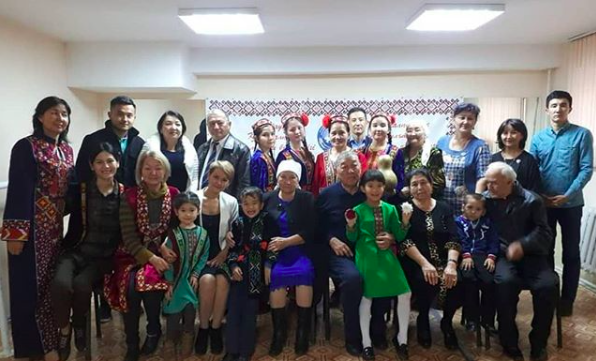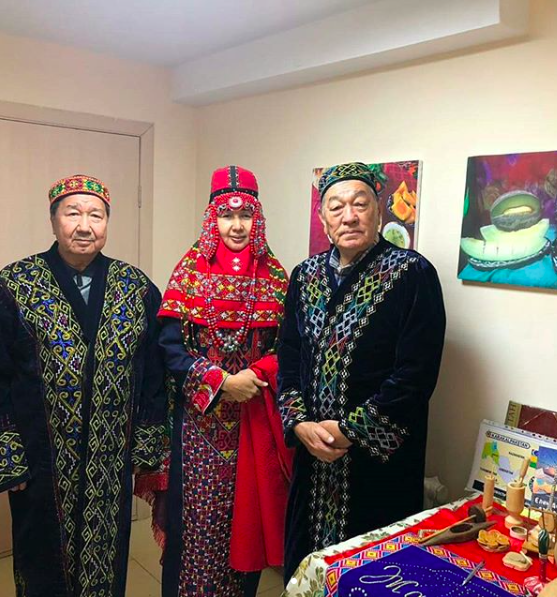A blog detailing the culture, history, geography and nature of the Republic of Karakalpakstan and neighbouring areas on the lower reaches of the Amu Darya River.
Saturday, July 18, 2020
Modern day Karakalpaks living in Kazakhstan
Karakalpaks’ unique culture worth celebrating and preserving in Kazakhstan, says community leader
BY DILSHAT ZHUSSUPOVA in PEOPLE ASTANA Times
ASTANA – The Karakalpak ethno-cultural centre Zhaikhun has consolidated the Karakalpak community’s cultural development in the capital since 2016, said the community’s leader Tazabike Saliyeva.
The Karakalpaks, an ethnic group native to Karakalpakstan in northwestern Uzbekistan, number approximately 620,000 worldwide, 56,000 of which reside in Kazakhstan. The group settled on the Amu Darya river in the 18th century and may also be found in significant numbers in Russia and Turkmenistan. Their name comes from the words kara (black) and kalpak (hat).
Kazakhstan’s Karakalpak community began to develop in its first years of independence. Twenty-six years ago, the Karakalpak association Alayar Zholy was established in the Mangyshlak region. Later, similar associations emerged in Almaty – Bes Kala and Amiyu Zhahasy, Atyrau – Yedil Zhaiyk and Shymkent – Amiyu Sheshekleri.
“The Karakalpak ethno-cultural association Zhaikhun was established in Astana Dec. 9, 2016. Since then, we have been actively participating in all events held by the Assembly of the People of Kazakhstan in the capital,” said Saliyeva.
The Karakalpaks’ language, customs and material culture are similar to other Central Asian groups, particularly that of the Kazakhs. The group uniquely preserves its rich folklore through oral folk art, with many tales and epics set to music. Interestingly, it is dance that brought the community and its leader together in Astana.
“As a choreographer, I have worked with many national centres in the capacity of a dance director. I was sad to discover that, among these centres, there was not a single Karakalpak centre showcasing the group’s rich culture, history, customs and literary heritage. For instance, 156 volumes of Karakalpak oral folk art have been preserved. We thus decided to create our own centre, the Karakalpak ethno-cultural association Zhaikhun,” said Saliyeva.
“The centre actively participates in charity, dance, fashion and music events” and seeks to expand its activities, she noted.
“We aim to find as many representatives of the Karakalpak nation as possible and help them preserve their language, customs and culture. In my opinion, this aim is pursued by every association in the Assembly of the People of Kazakhstan,” she said.
https://astanatimes.com/2018/11/karakalpaks-unique-culture-worth-celebrating-and-preserving-in-kazakhstan-says-community-leader/
Wednesday, July 8, 2020
Jalal ad-Din Mingburnu, the last Khwarazmian Shah .
Jalal ad-Din Mingburnu
His full name was Jalal ad-Dunya wa ad-Din Abul-Muzaffar Manguberdi ibn Muhammad. He was better known as Jalal ad-Din Mingburnu or Jalal ad-Din Khwarazmshah. The son of Shah Ala ad-Din Muhammad II, the man responsible for causing the Mongol invasion of the Khwarazmian Empire.
The newly formed Mongol Empire wanted to trade with the wealthy Khwarazmians and Shah Muhammad II agreed. However the peace was not to last. Soon after a Mongol trading caravan was arrested by a Khwarazmian governor. Genghis Khan sent three messengers to Muhammad II himself, demanding the immediate release of the trading caravan. The Shah had the messengers beheaded. He then ordered the execution of the trading caravan. This resulted in the Mongol invasion of Khwarazmian and the fall of this great empire.

The Khwarezmian Empire at it’s greatest extent 1n 1220 (800 years ago).
The Mongols began their invasion in 1219 and in just over a year the empire was now under Mongol control. Shah Muhammad II fled westwards to a barren island in the Caspian Sea where it is said he died of thirst in 1220.
The fate of the empire now rested in the hands of the young Sultan, Jalal ad-Din Mingburnu, who was only 20 years old at the time. Jalal ad-Din and members of the army (who had survived the onslaught) were forced to flee southwards towards the Hindu Kush. Here he made new alliances with the Afghans and swelled his army to 60,000 men.
The two armies would meet in the Battle of Parwan in 1221 naer modern day Kabul. The Mongol general, Shigi Qutugu, was extremely overconfident as the Mongols had very easily defeated the Khwarezmians in every single battle. He did not initially realize that his army which numbered around 30,000–40,000 was outnumbered. The valley was ill-suited for cavalry. Still confident the Mongols chose to face Jalal ad-Din in direct battle. Over half of the Mongol army was killed in battle and the other was forced to retreat. The image of invincibility that the Mongols had created for themselves was shattered. It was the first time the Mongols had ever been beaten.
Genghis Khan began once again to gather the Mongol army and again face off against the young Sultan. Unfortunately for Jalal ad-Din a disagreement with the Afghans (over a horse belonging to the Mongol General) resulted in tensions with his new allies. Soon he lost the Afghan support altogether. Jalal ad-Din decided to flee eastwards towards the Indus with his army of about 20,000 men and thousands of Khwarezmian refugees. Genghis Khan realising the young Sultan’s plans followed him with haste hoping to catch him before he crossed the Indus river. He brought with him some 200,000 men. The Mongol army caught up with Jalal ad-Din at the banks of the Indus river and forced the Khwarezmians to fight with their backs to the river. The initial Mongol charge was held off and the following counterattack almost broke the Mongol ranks but the Mongol army was far too great. Jalal ad-Din and his surviving army however had time to cross the Indus river and escaped from wrath of Genghis Khan.
Battle of Indus River. Jalal ad-Din crosses the river to escape.
Jalal ud-Din sought asylum under the Delhi Sultanate but was denied. He then formed an alliance with the rulers of Lahore and captured much of Punjab. The Delhi Sultan and his forces then marched on Lahore forcing Jelal ud-Din to flee once more this time to Persia.
In Persia, he formed new alliances to re-establish the Khwarezmian Empire. He however to do so he had to go into battle against the Ayyubids and the Seljuk princes. He managed to capture many regions such as Tbilisi, Fars, Kerman, Tabriz and Isfahan. however the new Khan Ögedei Khan sent a large army to the region. The resurgent Khwarezmian armies were defeated and scattered. Jalal ad-Din was forced to flee once more. In 1231, the last Khwarezmian, Jalal ad-Din Mingburnu, was murdered by a Kurdish assasin..
A statue of Jalal ad-Din stands proud in Urgench, Uzbekistan
Jalal ad-Din bravery in facing the Mongols however became legendary,
Prior to Mongol expansion
Footnote: The genocide of the Khwarezmians by the Mongols is considered one of the worst in human history. According to historians the Mongols reduced the population of this region to 200,000 from over 2 million prior to the invasion. leaving 1.8 million people dead at the very least. Only one out of every 10 people survived.
Some of the worst examples of the Mongol conquest of Khwarezmia included the destruction of Samarkand the capital of the empire. It took the Mongols five days to take this well fortified city. After a failed counter attack, its defenders lost hope and surrendered. This, however, would not save them. The Mongols would break the terms of surrender and kill the defenders anyway. The citizens were taken out of the city where most were killed.
Likewise the city of Urgench the second capital of the empire was raised to the ground despite being well protected by the Amu river. The Mongols Khan tasking each soldier to bring back the heads of 24 Khwarezmians. The women and children were taken as slaves and all the men killed. This however was not enough for the Mongols. The nearby dam that irrigated the region was destroyed, flooding the City and surrounding lands in Khoresm.
But perhaps Merv was the city that suffered the most. The city of Merv was filled with refugees. People seeking to escape the from the incoming Mongol horde. It fell after just seven days. On the eighth, they surrendered to the Mongols on the promise that the citizens of the city would be spared. As soon as the city handed over control to the Mongols, the massacres began and except for 400 artisans, everyone else was killed.
The city of Merv (now in Turkmenistan)
Subscribe to:
Comments (Atom)



